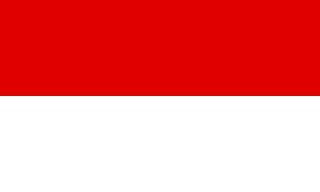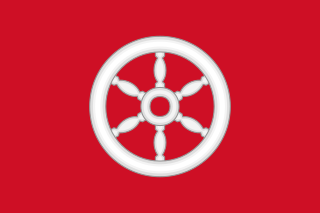
Hermann Karl Hesse was a German-born poet, novelist, and painter. His best-known works include Demian, Steppenwolf, Siddhartha, and The Glass Bead Game, each of which explores an individual's search for authenticity, self-knowledge and spirituality. In 1946, he received the Nobel Prize in Literature.

Rhineland-Palatinate is a state of Germany located in the west of the country. Covering an area of 19,846 km2 (7,663 sq mi) and with a population of 4.05 million inhabitants, it is the seventh-most populous German state. Mainz is the state capital and largest city, while other major cities include Ludwigshafen am Rhein, Koblenz, Trier, Kaiserslautern and Worms. Rhineland-Palatinate is surrounded by the states of North Rhine-Westphalia, Saarland, Baden-Württemberg and Hesse. It also borders three foreign countries: France, Luxembourg and Belgium.

Hesse or Hessia, officially the State of Hesse, is a parliamentary republic in western Europe and, with just over six million inhabitants, a member state of the Federal Republic of Germany as of 1949. Its capital city is Wiesbaden, the largest metropolitan area is Frankfurt am Main.

Kassel is a city located on the Fulda River in northern Hesse, Germany. It is the administrative seat of the Regierungsbezirk Kassel and the district of the same name and had 200,507 inhabitants in December 2015. The former capital of the state of Hesse-Kassel has many palaces and parks, including the Bergpark Wilhelmshöhe, which is a UNESCO World Heritage Site. Kassel is also known for the documenta exhibitions of contemporary art. Kassel has a public university with 25,000 students (2018) and a multicultural population.
Fulda is a Kreis (district) in the north-east of Hesse, Germany. Neighboring districts are Hersfeld-Rotenburg, Wartburgkreis, Schmalkalden-Meiningen, Rhön-Grabfeld, Bad Kissingen, Main-Kinzig, Vogelsbergkreis.

The Electorate of Mainz, previously known in English as Mentz and by its French name Mayence, was one of the most prestigious and influential states of the Holy Roman Empire. In the Roman Catholic hierarchy, the Archbishop-Elector of Mainz was the Primate of Germany, a purely honorary dignity that was unsuccessfully claimed from time to time by other archbishops. There were only two other ecclesiastical Prince-electors in the Empire: the Electorate of Cologne and the Electorate of Trier.

The Fulda is a river of Hesse and Lower Saxony, Germany. It is one of two headstreams of the Weser. The Fulda is 220.4 kilometres (137.0 mi) long.

Siddhartha is a novel by Hermann Hesse that deals with the spiritual journey of self-discovery of a man named Siddhartha during the time of the Gautama Buddha. The book, Hesse's ninth novel, was written in German, in a simple, lyrical style. It was published in the U.S. in 1951 and became influential during the 1960s. Hesse dedicated the first part of it to Romain Rolland and the second part to Wilhelm Gundert, his cousin.
Unstrut-Hainich-Kreis is a Kreis (district) in the north of Thuringia, Germany. Neighboring districts are the districts Eichsfeld, Kyffhäuserkreis, Sömmerda, Gotha, Wartburgkreis and the district Werra-Meißner in Hesse.

The Lahn is a 245.6-kilometer (152.6 mi)-long, right tributary of the Rhine in Germany. Its course passes through the federal states of North Rhine-Westphalia (23.0 km), Hesse (165.6 km), and Rhineland-Palatinate (57.0 km).

Katzenelnbogen is the name of a castle and small town in the district of Rhein-Lahn-Kreis in Rhineland-Palatinate, Germany. Katzenelnbogen is the seat of the Verbandsgemeinde Aar-Einrich.

Hesse-Homburg was formed into a separate landgraviate in 1622 by the landgrave of Hesse-Darmstadt; it was to be ruled by his son, although it did not become independent of Hesse-Darmstadt until 1668.

Hanau is a large town in the Main-Kinzig-Kreis, in Hesse, Germany. It is located 25 km east of Frankfurt am Main and is part of the Frankfurt Rhine-Main Metropolitan Region. Its station is a major railway junction and it has a port on the river Main, making it an important transport centre. The town is known for being the birthplace of Jakob and Wilhelm Grimm and Franciscus Sylvius. Since the 16th century it was a centre of precious metal working with many goldsmiths. It is home to Heraeus, one of the largest family-owned companies in Germany.

Rhenish Hesse or Rhine-Hesse is a region and a former government district in the German state of Rhineland-Palatinate, made up of those territories west of the Upper Rhine river that from 1816 were part of the Grand Duchy of Hesse and of the People's State of Hesse until 1945. The hilly countryside is largely devoted to vineyards, comprising the Rheinhessen wine region.
Bieber most commonly refers to Justin Bieber, a Canadian singer, songwriter and actor.

Babenhausen is a town in the Darmstadt-Dieburg district, in Hesse, Germany.

The Selz is a river in Rhineland-Palatinate, Germany, and a left hand tributary of the Rhine. It flows through the largest German wine region, Rheinhessen.

The Wisper is a 29.715-kilometre-long (18.464 mi) river in Hesse, Germany, right tributary of the Rhine. Its source is in the western Taunus, Rheingau-Taunus-Kreis district, near a small village named Wisper. It flows southwest through a densely forested valley with some medieval castle ruins surrounded by a popular hiking area. A man-made lake, the Wispersee, is stocked with trout and is a popular fishing destination. The Wisper flows into the Rhine at Lorch.

The Grand Duchy of Hesse and by Rhine was a grand duchy in western Germany that existed from 1806 to the end of the German Empire in 1918. The grand duchy originally formed on the basis of the Landgraviate of Hesse-Darmstadt in 1806 as the Grand Duchy of Hesse. After the end of the Napoleonic Wars in 1815, it changed its name in 1816 to distinguish itself from the Electorate of Hesse, which had formed from neighboring Hesse-Kassel. Colloquially, the grand duchy continued to be known by its former name of Hesse-Darmstadt. It joined the German Empire in 1871 and became a republic after German defeat in World War I in 1918.

The Kahl is a river in the northern Spessart in Bavaria and Hesse, Germany. It is a right tributary of the Main and is 35.6 km (22.1 mi) long. The name Kahl comes from the Old High German word kaldaha, which means cool and clear. The Kahl rises from two sources left and right of the road at the foot of the Spessart hills, near Kleinkahl. These springs produce 50–60 litres per second. The Kahl flows into the river Main in Kahl am Main. The mouth is near the old Kahl Nuclear Power Plant. The largest tributaries are Westerbach, Sommerkahl, Reichenbach and Geiselbach.
















